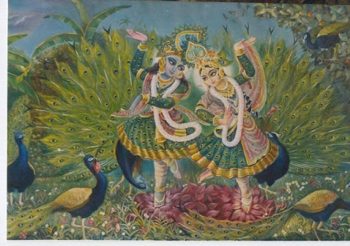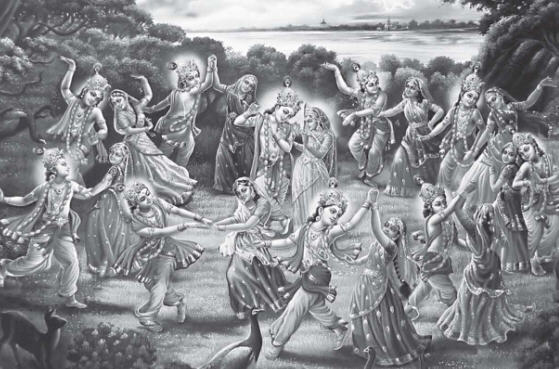
An English poetic rendition of the Tenth Canto tries to remove stereotyped notions of God as a
static and unsociable person and presents Him as the most dynamic personality.
“I could only believe in a God who dances.” – (Friedrich Nietzsche)

Kalakantha Dasa
This well known statement of the German philosopher Nietzsche was his rhetorical way of expressing his disdain and disbelief as regards the stereotype of God that he learned from the Judaeo Christian tradition of his times: A God who is remote, static and entirely unsociable; a God who is so grandly aloof that it would be demeaning for him to enter into any personal relationships with anyone; a God who, if given a choice, most people wouldn’t even care to know, leave alone love. Indeed, such poisonous stereotyped notions of God contributed greatly to the spread of godlessness and atheism.
But God does dance, as the Vedic literature profusely reveals. And though Nietzsche is no longer around, maybe his soul in some other body may be around to know about the God who dances. Even if his soul is not around on this planet, there are still many who are similarly alienated from God due to the stale conceptions of divinity being fed to them.
A God who dances: Krishna for you, an upcoming book by Kalakantha Dasa, is a panacea for people like these—as well as for all those who want to know more about the personable, loving side of God. The heart of this book is the love life of God as revealed in the Tenth Canto of Srimad Bhagavatam, which describes how God dances, plays and has fun with his devotees. What makes this book unique is that it renders the dance of God into engaging English poetry. It presents the ninety chapters of the Tenth Canto in thirty one English poems set to tunes that correspond to the tunes of the original Sanskrit. To help readers get a basic philosophical orientation, the Tenth Canto poetry is preceded by short, sweet summaries of the Bhagavad gita and the first nine cantos of the Srimad Bhagavatam.
Overall, the book is an excellent introduction for those who may want to know why the revelation of God as Krishna has charmed the hearts of millions throughout history and is charming millions all over the world today. And the book is also a charming refresher for all those who already know Krishna: reciting his pastimes in English poetry is an easy and pleasant way to rejuvenate one’s devotional memories of the Lord in the heart.
The author cum poet Kalakantha Dasa already has already written two poetry books, with his poetic rendition of the Gita, The Song Divine, which received critical acclaim. Here we present an interview with Kalakantha Dasa, who is well known and much loved as a Vaishnava poet.
BTG: Could you please tell us how you were introduced to Krishna consciousness and your services sincethen?
Kalakantha Dasa (KD): I was introduced through a harinama sankirtana party in downtown Portland, Oregon. It was 1972 and I was 18. A small band of devotees maintained a small temple in a rented house. I was immediately attracted and joined as a brahmachari shortly after attending my first Sunday feast. I soon met Srila Prabhupada and thus began my new life of service to him. After ten years as a brahmachari I married and have now been a grihastha for twenty eight years. During that time I’ve had a successful real estate career while maintaining service in ISKCON as a fund raising consultant and mediator. For the past five years I’ve returned to being a temple president, something I did for ten years in my early grihastha life.
BTG: What inspired you to present the Vedic literature in English poetry?
KD: It is my favorite way to study. Poeticizing the verse forces me to examine every word and nuance of meaning, to distill the message, to think of synonyms and to communicate the essence of it in a concise and rhythmic way. Somehow that fits my nature, and it allows me to contemplate verses naturally throughout the day.
BTG: Did you have an interest in composing poetry before being introduced to Krishna consciousness?
KD: Yes, a little. Kipling’s “If“ inspired me; a meaningful message, brilliantly composed, compact and poignant. I later discovered I could spend pleasant hours just trying to piece together the right words.
BTG: Have you noticed any similarities or differences between Western poets like Shelly and Tennyson and Vedic poets like Narottama Dasa Thakura and Bhaktivinoda Thakura?
KD: No, because the content is driven by such different motivations, they do not seem to me to be very similar.
BTG: Your book has an appealing title “A God Who Dances”. Can you tell us briefly how the Vedic revelation of Krishna as God is different from the conventional notions about God that you grew up with?
KD: I grew up with a concept of God so vague that everything associated with it became tasteless. When my sibling and I lost interest in church, so did my parents, and that was it. Later, after encountering the suffering and the chaos of adolescence, I started looking for a different, more meaningful understanding of God. There was so much confusion and junk on the subject that several times I almost gave up. The very fact that Srila Prabhupada could speak so forthrightly on God astonished me, and when I understood what he was saying, I realized he was right. No one else had such a complete concept of God.
BTG: You are the first person to have presented an English poetic rendition of the full Tenth Canto of the Srimad Bhagavatam; others have done poetic renditions of the Gita Govinda of Jayadeva Gosvami or the rasa panchadhyaya (the five chapters of rasa lila) in the Tenth Canto. What are the distinctive features of your presentation?
KD: The language is relaxed and meant for a contemporary audience. The meter of the poem generally changes according to the Sanskrit meter of the original. There is a subtle attempt to identify the main speakers (Vyasa and Sukadeva) without a lot of interruptions. The main feature, though, is the simple volume; there are 2160 quatrains (four line stanzas) distilled from the 3932 original verses. Though some are simply harder to poeticize than others, I have worked hard to make the quality of the verses even. Doing this forced me to go more deeply into Sanskrit pronun ciation. I realized I’d long been mispronouncing many Sanskrit names. Lokanatha Swami has written an amusing book on this subject, which I found helpful.
BTG: You have mentioned that in your book you wanted to give readers unfamiliar with Sanskrit a feel of the poetics and aesthetics of the Tenth Canto. What were the challenges in rendering poetry from one language to another—especially poetry imbued with profound wisdom and surcharged with deep emotion?
KD: Srila Prabhupada, Hrdayananda Gosvami, Gopiparanadhana Dasa and Dravida Dasa have done most of the work by their original translations. The challenge is picking out the essential parts of their erudite, thorough and academic translations without compromising the meaning. Then that essential meaning must be packaged as something pleasing to the ear with rhyme, alliteration, rhythm and style.
After publishing two previous poetry books I have found that poetry polarizes; those who like it (the minority) love it; the rest can’t get the beat and move on to something else.
The wisdom and drama and humor of the Tenth Canto really is extraordinary. When poeticizing it, I try not to get in the way. The practical benefit of this book is that you can read the whole Tenth Canto three or four times faster than the translations on which it is based. Thus for those who know the pastimes, it is a good, quick review.
One other observation: the Tenth Canto beautifully intertwines poetry and lila. Lila lends itself much better to poeticization, but the philosophy flows in and out very naturally.
BTG: Can you explain, through a sample of your poetry, how you convey the Sanskrit verse into a corresponding English meter while also attending to the various nuances of meaning and aesthetics?
KD: Here’s an example from the 10th chapter of the 10th Canto, Narada’s instructions to the sons of Kuvera.

By seeing their faces, one whose body has been pricked by pins can understand the pain of others who are pinpricked. Realizing that this pain is the same for everyone, he does not want others to suffer in this way. But one who has never been pricked by pins cannot understand this pain.
A poverty stricken man must automatically undergo austerities and penances because he does not have the wealth to possess anything. Thus his false prestige is vanquished. Always in need of food, shelter and clothing, he must be satisfied with what is obtained by the mercy of providence. Undergoing such compulsory austerities is good for him because this purifies him and completely frees him from false ego.
Always hungry, longing for sufficient food, a poverty stricken man gradually becomes weaker and weaker. Having no extra potency, his senses are automatically pacified. A poverty stricken man, therefore, is unable to perform harmful, envious activities. In other words, such a man automatically gains the results of the austerities and penances adopted voluntarily by saintly persons.
Saintly persons may freely associate with those who are poverty stricken, but not with those who are rich. A poverty stricken man, by association with saintly persons, very soon becomes uninterested in material desires, and the dirty things within the core of his heart are cleansed away.
Illusion makes the rich try to enjoy what they cannot,
but poor folks, on the other hand, can hardly give a thought
to sense enjoyment, seeking, as they do, a decent meal.
In poverty, one learns how other starving people feel.
Avoiding wealthy sense enjoyers, saints live with the poor
another reason destitutes can spiritually mature.
BTG: What advice would you give budding devotee poets?
KD: Do it for self purification and because you enjoy it. Avoid taking your writing hobby too seriously. Especially with poetry, don‘t expect to get published, and don’t expect others to be very interested.
BTG: What is the best way in which readers can relish the poetry of A God Who Dances in particular and devotional poetry in general?
KD: I’d hoped people would be able to read it aloud, but the inflections, so clear in my mind but hard to translate in print, as well as the aforementioned Sanskrit names, can make it a little hard. Still I hope readers will try. I plan to record the poem in a simple way and put it on our website, agodwhodances.com. That may help those who are interested.
Otherwise, one way to enjoy devotional poetry is by memorization, smaranam. Some scholars can rattle off Sanskrit without a clear idea of the meaning. The rhyming, succinct translation can be easier to internalize. Dravida Dasa has turned shorter Vaishnava texts into brilliant and highly memorizeable poems.
Rhyming poetry can also capture children’s attention when read aloud for them. And, on a lighter note, A God Who Dances, like my other books, is likely to be excellent for insomniacs.
The interview was conducted by Caitanya Carana Dasa on behalf of BTG.
